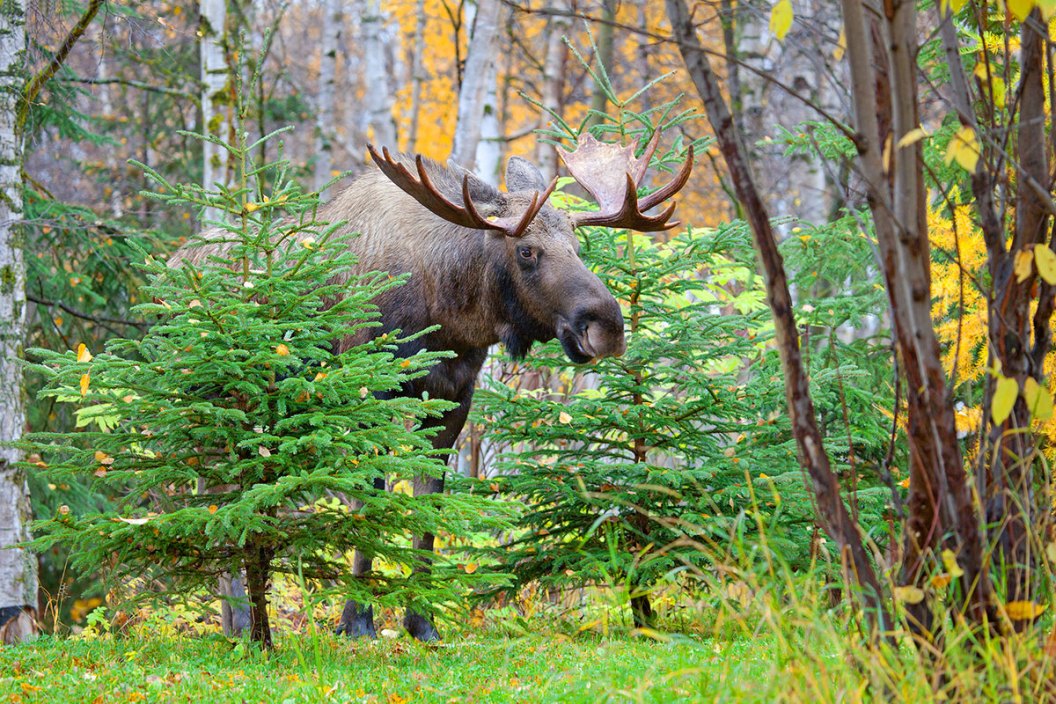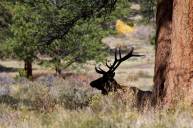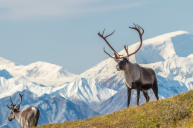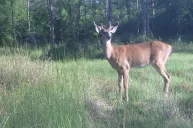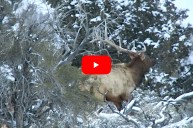Yes, of course moose shed their antlers, but here are 10 other things you didn't know about the world's largest deer.
For those that didn't know, the moose is a North American ungulate that is the largest member of the deer family, and its reputation as a large creature is sometimes intimidating.
As if reaching seven-feet tall at the shoulder isn't enough, these giants of the north country can routinely weigh in at over 1,000 pounds or more, not counting the head and antlers. But there's more to the awe inspiring moose than just how big and lumbering they are.
One thing that you might already know is that the moose is found in the United States and Canada, particularly in the Canadian Yukon and Alaska. For a creature that is so well suited to living in the cold, and still has a viable population in many areas, the moose is having some issues in others. In parts of the Northeast and stretching into Minnesota, moose are struggling due to loss of habitat, winter tick infestations, and even things like brain worms, bacterial infections or possibly liver flukes.
Let's zoom in on some moose facts to not only learn yourself, but to impress your friends, perhaps apply to viewing or hunting strategies, and maybe even influence efforts to conserve their habitat and overall well-being.
Do Moose Shed Their Antlers?
Like all deer species, the male moose sheds its antlers annually during the winter, and begins growing them back throughout the rest of the year.
How Long is a Moose?
An adult moose can have a general length of about eight to 10 feet from the tail to the head. That makes them about as long as a compact car or a couple of average-sized Harley Davidson motorcycles.
How Much Does a Moose Weigh?
A Yukon-bred bull moose can weigh in at around 1,500 pounds, making it the second heaviest land mammal in its range. The only thing that is bigger in North America is a bull bison, which can reach upwards of 2,000 pounds.
The biggest bull moose ever recorded was a Yukon beast that weighed around 1,800 pounds.
How Good is Moose Vision?
Moose are terribly near-sighted. They are also color blind due to the fact that they have a shortage of cones in their eyes, but they more than make up for it with great senses of smell and hearing.
Moose are well known for having comical run ins with things they think are a threat, such as parked cars and mailboxes.
How Fast Can a Moose Run?
An adult moose, especially a cow, can run at speeds of up to 35 mph and even sustain those speeds in snow up to their belly. Though it may seem slow, think about a car driving through a neighborhood street. You wouldn't keep up with that car if you were on foot, and a moose can run even faster.
Are Moose Good Swimmers?
Moose are incredible swimmers and are known to be able to swim many miles, sometimes up to 12 at a time. An adult bull moose can dive to depths of up to 17 feet and stay below the surface for up to a minute at a time, sometimes swimming at a speedy rate of six miles per hour.
What Do Moose Eat?
Moose are so tall that they have difficulty bending down to eat grasses, so they prefer to feed on leaves, bark, and twigs from trees and shrubs.
Some of their favorite foods come from willow, aspen, and balsam fir trees, but moose are right at home sucking up aquatic vegetation like pondweed and water lily.
Life Expectancy: How Long Does a Moose Live?
According to the USFWS, "The average life expectancy is 8 years for a cow and 7 years for a bull. Moose may live into their late teens, but rarely live past 20."
Sodium Importance: Why Do Moose Lick Roads and Cars?
Salt is a great source of potassium, calcium, and magnesium for moose, but it's not always easily found for these large animals. That's why moose often head to the roadside in search of salt to satisfy this nutrient need.
This can cause some obvious issues, since the salt used to treat roads is not good for them and this can naturally cause auto-animal accidents.
What Color is Moose Hair?
Moose range in color from light brown to a very dark brown with bulls tending to be darker than the cows. The color variation is especially noticeable in the facial region, especially in the neck.
Bulls and cows both have a long flap of skin beneath their throat called a bell, which is more pronounced on the bull.
More Interesting Moose Facts
- A moose's nostrils can close while under water.
- Bulls drop their antlers earlier the other ruminants, starting around December.
- A cow moose with a calf or calves is known as one of the most dangerous animals in North America.
- It is said that if a bull moose is castrated, it will immediately shed its antlers and grow a new pair of deformed "Devil's antlers" that will never shed.
- Moose eat about 70 pounds of food per day.
- Moose comes from the Native American word "Moswa," which roughly translates to "twig eater."
More About Those Antlers
Again, moose are the largest members of the cervidae family which are the hoofed ruminants including whitetail deer, mule deer, fallow deer, roe deer, chital, reindeer, and elk just to name a few. After rutting, when the testosterone levels drop, the base of the pedicle where the antlers are attached to their head softens and ultimately gives way, dropping off of the head.
The same goes for the moose, just in a really big way since their antlers are some of the biggest in nature. Moose antlers can retail for around $10 a pound and sometimes they weigh as much as 30 pounds. Many artists use them for sculpturing, making chandeliers, and some are even sold as mounts.
As their age increases, antler weight rapidly increases. The average weights from large, mature bulls (8-10 years old) are 45-50 pounds, and it is probable that some very large moose antlers weigh 75 pounds or more.
According to Alaska Adventure Outfitters, "For Boone and Crockett scoring, the minimum Alaska-Yukon record book score is 210, All-time record is 224. The World record moose scored 261 5/8 and was taken in Alaska game management unit (GMU) 20."
Moose antler scores are determined by combining the following statistics:
- Greatest measured length of spread
- Total number of points
- Length of both palms (the brow palm as well)
- Width of both palms
- Circumference of both bases measured at smallest place
While female moose won't be found growing antlers, they are an integral part of the breeding season. When the rut occurs in the fall and the mating season is in full swing, male moose begin their assertion of dominance in the northern woods and swampy wetland ecosystems and when it's all over, the spring of the year will be replete with the new yearlings that will eventually take over for their parents.
Looking for a little more or even hot lunch for your hunting blind? Follow my webpage, or on Facebook and YouTube.
NEXT: FOOTAGE CAPTURES RARE ADIRONDACK MOOSE
WATCH
